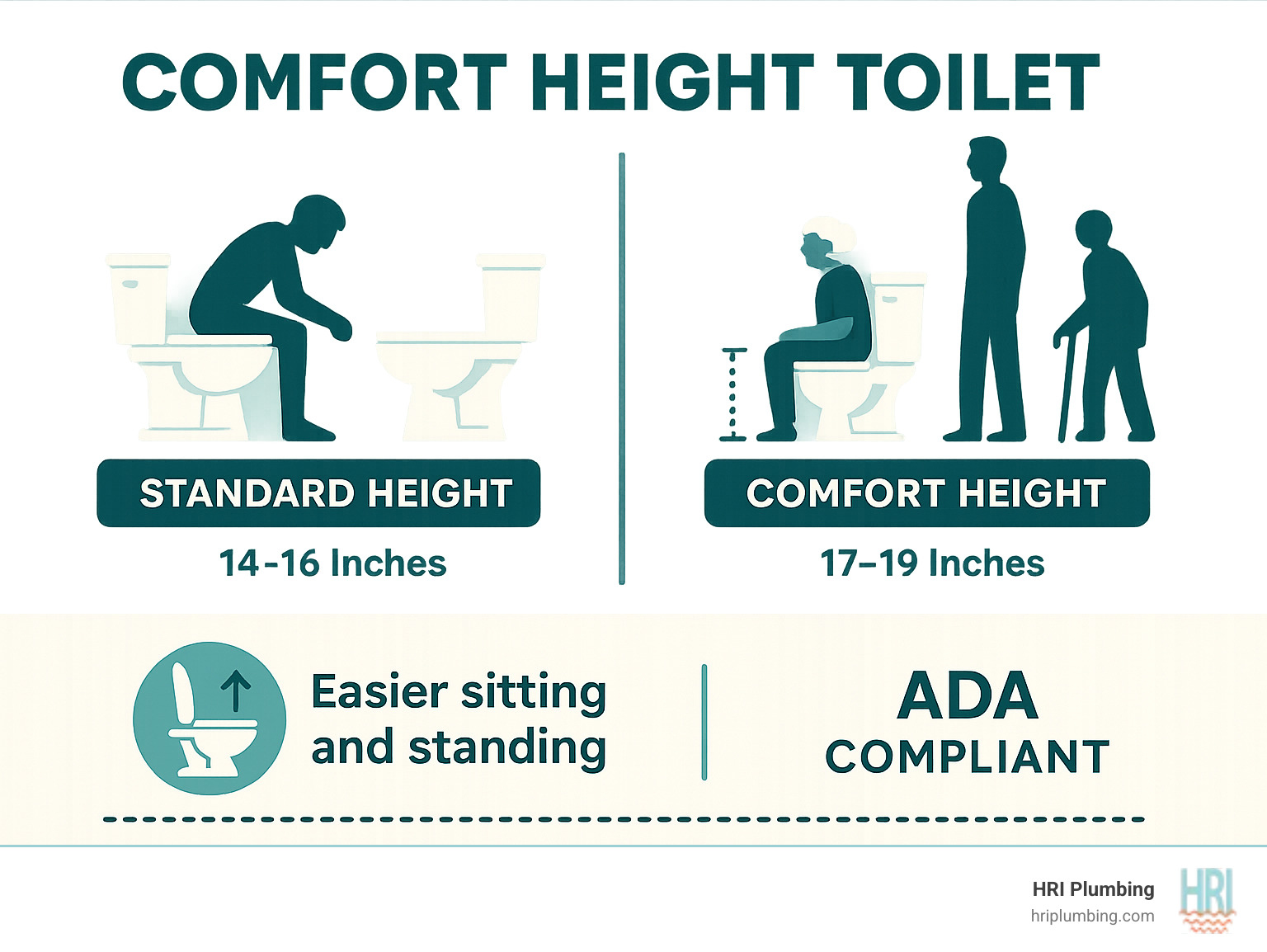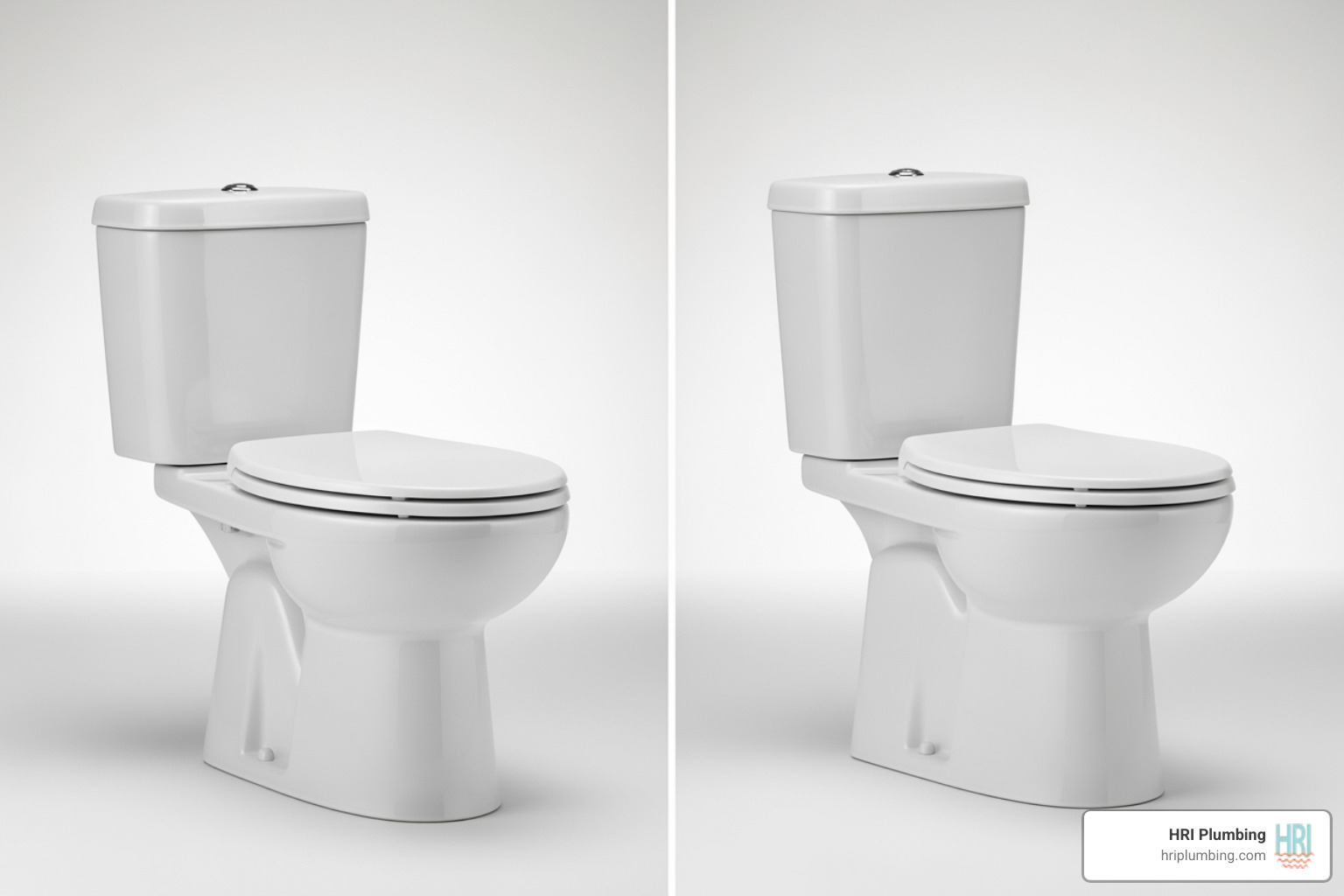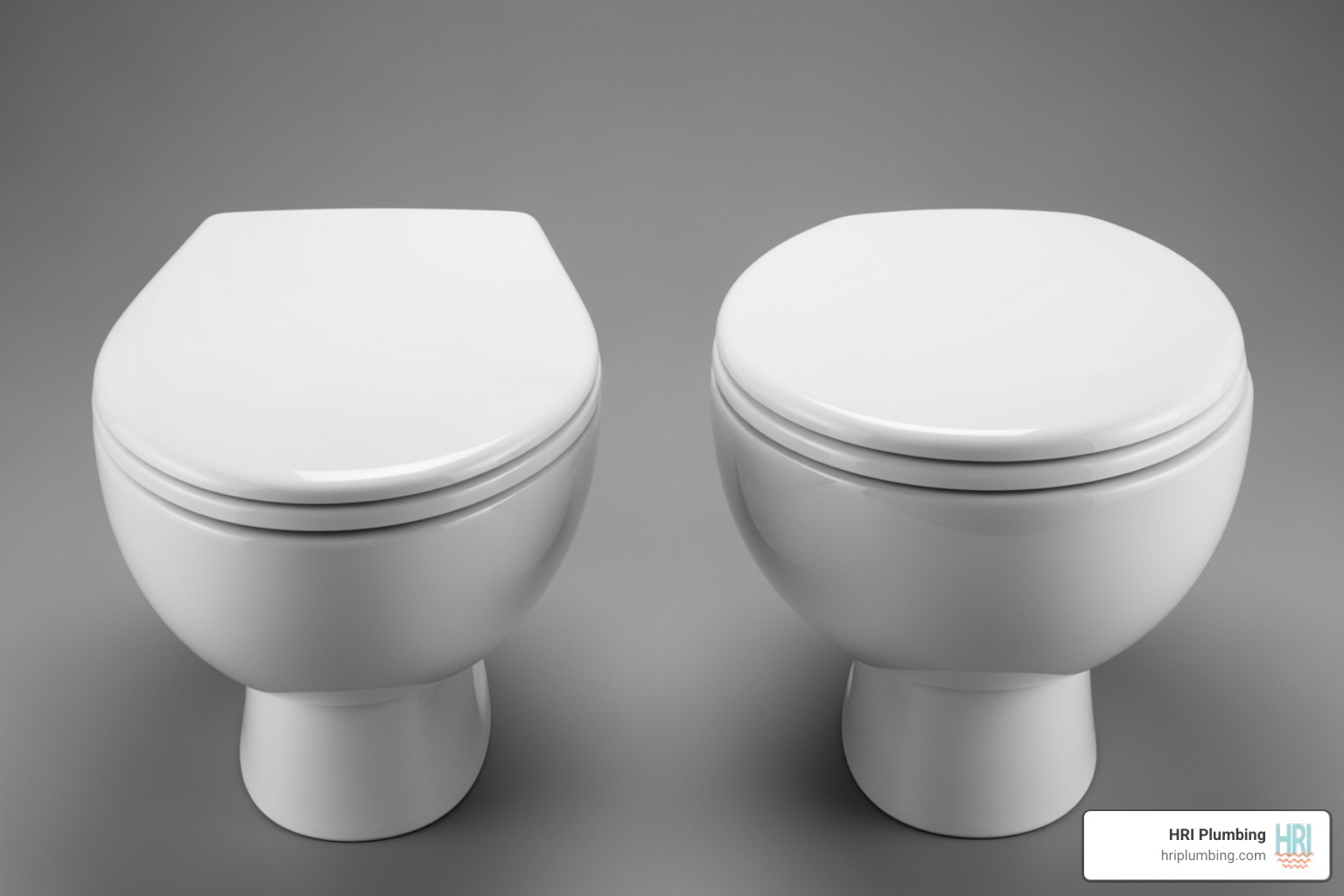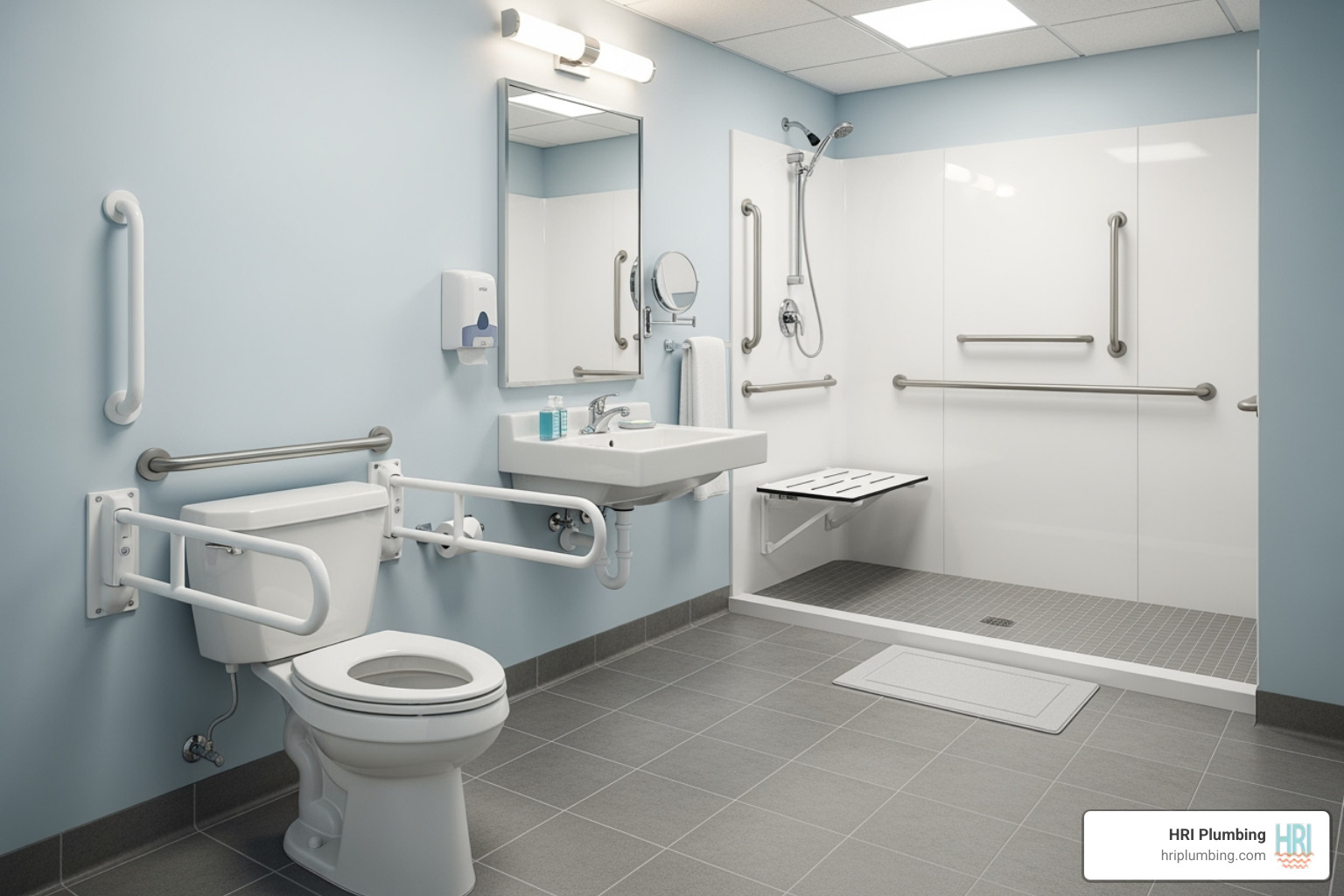Elevating Your Comfort: An Introduction to Modern Toilets
A comfort height toilet is a taller toilet measuring 17-19 inches from floor to seat, compared to the standard 14-16 inches. This design makes sitting down and standing up easier, especially for taller individuals, the elderly, and people with mobility challenges.
Key differences at a glance:
- Standard height: 14-16 inches tall
- Comfort height: 17-19 inches tall
- Also called: Chair height, right height, or ADA-compliant toilets
- Best for: Taller people, seniors, those with joint pain or mobility issues
- Benefits: Easier sitting/standing, reduced knee strain, improved accessibility
When planning a bathroom renovation, the height of your new toilet matters more than you might think. Comfort height toilets have grown in popularity because they solve real problems. If you've ever struggled with knee pain when getting up from a low toilet, or if you have family members who find standard toilets uncomfortable, a comfort height model can make a significant difference.
The extra 2-4 inches aligns these toilets with the height of most chairs, making transitions feel more natural. This simple change improves bathroom safety, reduces strain on joints, and makes your bathroom more welcoming for guests of all ages and abilities.

When it's time for an upgrade, understanding your options is key. Homeowners are often surprised by the variety of choices, especially regarding toilet height. If you've noticed signs you may need to invest in a toilet replacement, exploring a comfort height toilet could be a game-changer for your household's comfort and accessibility.
What is a Comfort Height Toilet and Who Benefits Most?
Let's dive deeper into what makes a comfort height toilet distinct and why it might be the perfect fit for your home. It’s about a significant improvement in daily comfort and bathroom accessibility.
Defining the Difference: Height and Ergonomics
A comfort height toilet (also called a "chair-height" or "universal height" toilet) is taller than its traditional counterpart. While standard toilets measure 14 to 16 inches from the floor to the seat, comfort height toilets stand at 17 to 19 inches. This difference has a huge impact on how easily you sit down and stand up.

Think of it as the difference between sitting in a comfortable chair versus crouching. A comfort height toilet reduces the need to bend or squat deeply, alleviating pressure on the knees and back. This is why they are often ADA (Americans with Disabilities Act) compliant, as the height falls within the required range for accessible restrooms.
Here's a quick comparison:
MetricStandard Height ToiletComfort Height ToiletHeight14-16 inches (floor to seat)17-19 inches (floor to seat)Ideal UserChildren, shorter adults, traditional preferenceTaller individuals, elderly, those with mobility issues, joint painProsCompact, traditional feelEasier sitting/standing, reduced strain, ADA compliant, improved postureConsCan be difficult for some users to sit/stand, more strain on jointsMay be too tall for small children or very petite individuals
This ergonomic design promotes a more natural and comfortable posture, making your bathroom experience a true relief.
The Primary Benefits for Your Household
The advantages of a comfort height toilet make it a truly inclusive choice.
- For the Elderly: The higher seat reduces the effort and risk of sitting and standing, providing stability and promoting independence.
- For Taller Individuals: A comfort height toilet allows for a more natural leg position, similar to a regular chair, reducing strain on the knees and lower back.
- For Individuals with Mobility Challenges or Joint Pain: The reduced range of motion minimizes stress on vulnerable joints, making a difficult task manageable. This is why these toilets are often called "ADA compliant." You can read more about the ADA Standards for Accessible Design to understand the requirements for accessible facilities.
- Increased Safety: The easier transition offered by a comfort height toilet contributes significantly to bathroom safety, especially when combined with features like grab bars.
- Universal Design Principles: A comfort height toilet helps create an environment that is usable by all people, making your bathroom welcoming for every family member and guest.
While a comfort height toilet offers numerous benefits, a small footstool can easily remedy the height for young children or petite individuals, ensuring comfort for everyone.
Key Features Beyond the Height of a Comfort Height Toilet
Modern comfort height toilets come with various features to improve comfort and efficiency.
- Bowl Shape (Elongated vs. Round):
- Elongated bowls are about 2 inches longer than round ones and are generally more comfortable for adults. They also tend to be more hygienic.
- Round bowls are more compact, making them a good choice for smaller bathrooms.

- One-Piece vs. Two-Piece Design:
- One-piece toilets integrate the bowl and tank into a single, seamless unit. They are sleek and easier to clean but can be heavier to install.
- Two-piece toilets have a separate tank and bowl. They are generally lighter, easier to install, and more budget-friendly.
- Skirted Design: This feature covers the trapway with a smooth base, making the toilet much easier to clean and providing a contemporary, streamlined look.
- Soft-Close Seats: This feature prevents the lid and seat from slamming shut, eliminating noise and protecting the toilet from damage.
Choosing the right features can significantly impact your toilet's performance. If you're experiencing issues like constant clogs, these might be indications you could need expert toilet repairs. Upgrading to a comfort height toilet with modern features could resolve many common frustrations.
Practical Considerations for Your New Toilet
Once you've decided on a comfort height toilet, it's time to consider the practical details that ensure your investment is worthwhile.
Flushing Technology and Water Efficiency
Modern comfort height toilets feature impressive technology that saves water and improves performance. While older toilets could use 3.5 to 7 gallons per flush (GPF), today's high-efficiency toilets use just 1.6 GPF or less, with some ultra-efficient models using only 1.28 GPF.
Look for the WaterSense label from the EPA, which certifies that the toilet uses at least 20% less water than the federal standard without sacrificing performance. This helps the environment and your wallet.
- Gravity-fed flush systems are the most common. They are reliable, quiet, and have fewer moving parts that can break.
- Pressure-assisted flush systems use a pressure vessel for a powerful flush that prevents clogs, though they are noticeably louder.
- Dual-flush mechanisms offer two options: a light flush for liquid waste (using as little as 0.9 gallons) and a full flush for solid waste (1.6 gallons), allowing you to use only the water you need.
Even with the best technology, you might face clogs. Knowing some emergency solutions for stubborn toilet clogs is always helpful, but a powerful, efficient toilet can significantly reduce these issues.
Installation and Maintenance Insights
Proper installation is key to years of reliable service. The most critical measurement is the rough-in size—the distance from the wall to the center of the drainpipe. Most homes have a 12-inch rough-in, but always measure to ensure your new toilet will fit.
While DIY installation is tempting, we strongly recommend professional installation. A small mistake can lead to leaks, wobbling, or poor flushing. Our team at HRI Plumbing ensures your comfort height toilet is perfectly installed and functioning from day one. If you're wondering why hire a pro to install your new toilet, think of it as peace of mind for your investment.
Maintenance is simple. Clean regularly with gentle, non-abrasive cleaners to avoid damaging the finish or internal parts. A skirted design makes cleaning even easier, with smooth sides that wipe down effortlessly.
Periodically check for leaks around the base and at all connections. Even small leaks waste water and can cause floor damage over time.
How a Comfort Height Toilet Improves Bathroom Accessibility
Installing a comfort height toilet transforms your bathroom into a more accessible environment for everyone, aligning with the principles of universal design.

A comfort height toilet is crucial for aging in place, allowing people to maintain independence in their homes. The height often matches mobility devices like wheelchairs, making transfers safer and easier.
For maximum accessibility, combine a comfort height toilet with other features like grab bars for support and walk-in showers to eliminate tripping hazards. Together, these elements create a bathroom that is safe and comfortable for all.
At HRI Plumbing, we understand that accessibility is about creating spaces where everyone feels secure. We serve Jacksonville, Springfield, and Rushville with comprehensive bathroom remodeling that prioritizes style and function. From selecting the perfect comfort height toilet to coordinating the finishing touches, we are committed to delivering results that reflect our values of honesty and integrity. You can find more info about bathroom remodeling services on our website to see how we can transform your bathroom into the accessible, comfortable space you deserve.












